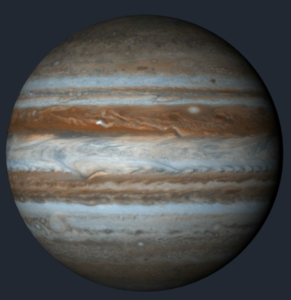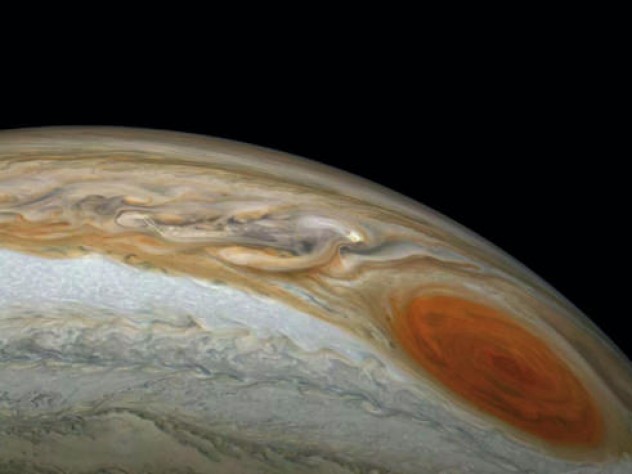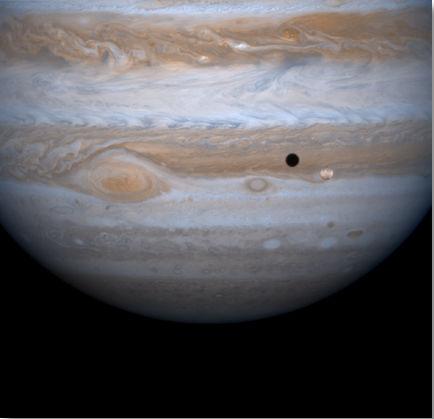
Jupiter is the largest planet in the Solar System. Located 778.3 million km from the Sun, it takes almost 12 Earth years to orbit it. Its mass is two and a half times the combined mass of the rest of all the planets combined. The planet has a weak inner ring made up of small rocks and microscopic dust. Like the Sun, Jupiter is composed of 82% of hydrogen, 17% of helium and 1% of other elements.
Its internal structure is deduced through theoretical models, concluding that inside there is a rock core 20,000 km in diameter (concentrating 4% of its mass); It is covered by a 40,000 km thick mantle of liquid metallic hydrogen (responsible for Jupiter's magnetic field). Above this sea of hydrogen lies a layer of clouds and gas 20,000 kilometers thick.
Jupiter, the giant planet
Jupiter radiates several times the energy it receives from the Sun. This additional energy is due to the fact that its large gravitational field contracts the planet, so the gases compress and heat up, radiating said heat. Because of its rapid rotation, Jupiter's clouds are grouped into elongated bands of different colors, each band rotating around the planet's surface in opposite directions with respect to each other.
A visible feature of Jupiter's turbulent atmosphere is the Great Red Spot, an enormous storm lasting more than 300 years, which could fit a pair of Earth planets. The chemical composition and its atmospheric agitation is responsible for the cloud belts and a constant change in their appearance, in which lighter areas represent colder clouds (-140 °C). A characteristic fact about this planet is that due to its size, scientists calculated that with a little more mass, it would have become a star that would accompany the Sun as a binary system.

As you advance to the center of the planet, the temperature and pressure increase, while the atmosphere becomes denser and its properties change. At a depth of 50,000 km, the pressure is so great that the hydrogen solidifies and resembles the structure of a metal. Its rapid rotation speed (9 h) causes an oblateness in Jupiter's polar region. Its powerful gravity is responsible, among other things, for the existence of the space between Jupiter and Mars. main asteroid belt, which has been theorized that in the remote past could have constituted a planet, destroyed by the immense gravitational influence of the gas giant; However, if all the masses of this belt were added, it would only be enough to form a body that would not reach the size of the Moon.
Jupiter has been visited on several occasions. First were the Pioner 10 and 11 missions, with flybys in the '70s; Later, the Voyager 1 and 2 missions at the end of the '70s made important discoveries, confirming the Jovian ring system and discovering new satellites. The Galileo mission, in the mid-1990s, investigated Jupiter for 7 years as well as its main moons, discovering active volcanism on the moon Io and surface ice sheets on the moon Europa. In 2000, the Cassini-Huygens mission, whose main destination was the planet Saturn, also made observations of Jupiter with much better quality than its predecessor probes.

| CHARACTERISTICS | |
| Diameter | 142,984 km |
| Mass | 1,899 x 1027 kg |
| Density | 1.33g/cm3 |
| Gravity | 23.12 m/s2 (23 Earth) |
| Surface temperature | -121 ºC (med) / -163 ºC (min) |
| Axial inclination | 3.12° |
| Escape velocity | 59.54 km/s |
| Rotation | 9h 55m |
| Translation | 11 a.m. to 315 d 1 h |
| Orbital speed | 13.07 km/s |
| Eccentricity | 0,04839266 |
| Albedo | 0,52 |
| Distance to the Sun (average) | 778,330,000 (5.20 AU) |
| Number of satellites | 80 (known) |

